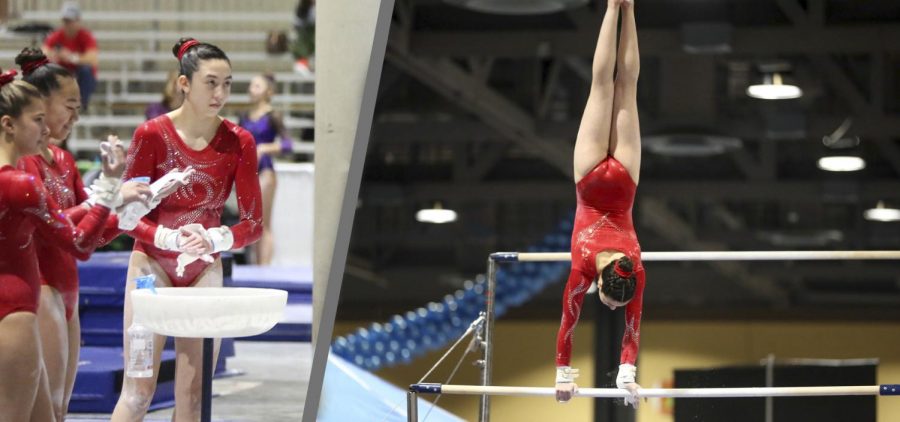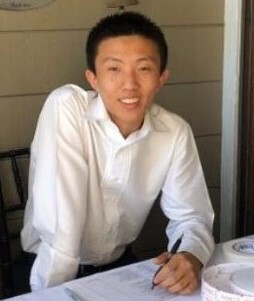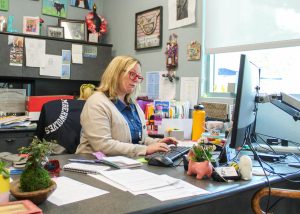Twist and turn: Interviewing superstar gymnast Katie Blam
DEFYING GRAVITY: Senior Katie Blam prepares and performs her individual bar routine at the USA international competition.
March 22, 2021
Choosing balance beams over tracks and basketball hoops, gymnast and senior Katie Blam spent her high school years going to gyms over the school field. Blam has competed at the highest levels of gymnastics, winning a gold medal for the balance beam event as a member of the 2019 Team USA at the Pan American Maccabi Games. Her days as a competing gymnast might have come to a close due to injuries, but she continues to be involved with the sport by coaching aspiring gymnasts.
The Howler: How did you get started in gymnastics and what has kept you competing?
Katie Blam: The first time I was dragged to a gym class, I screamed and cried so much the instructor told my parents that I was not ready for this. I came back eventually and found it fun that time, starting “real” gymnastics classes at age 7 and competing when I was 11. I loved the power and focus that came with the intensity of competition and found a certain satisfaction from completing a routine regardless of whether or not I hit every skill or fell on my butt. The excitement and enjoyment I found in competing kept me looking forward to training sessions, and it was so much fun to cheer on my teammates and watch each other progress year after year.
TH: How did you manage to balance time between school and sports?
KB: I trained 22 hours a week, practically every week of the year. My parents would insist on taking time out for family trips and vacations, but I had to make the decision to pass on things because I had to practice. I got really good at doing homework and eating meals in the car on the way to and from practice.
TH: What do people overestimate or underestimate about gymnastics?
KB: Gymnasts are continuously refining and upgrading our skills. Regardless of a skill’s difficulty, we are always looking to add another half twist or another turn. Something that I have noticed and might be surprising to many people is that gymnasts are klutzy. We hang on to the bars by our fingertips and grip the balance beam with our toes, but we have trouble walking down the street without tripping over ourselves.
TH: What’s something you would tell people who are on the fence about trying gymnastics?
KB: Most people hesitate because they think that flipping and twisting in the air is scary. The question whether you are willing to push through your fears and to work towards your goals one excruciatingly small step at a time. And more importantly, will you have fun doing it? If the answer is yes, go for it!
TH: What are your thoughts on promoting gymnastics to a broader audience through public schooling?
KB: Unfortunately, gymnastics is one of those sports where you have to start relatively young. Getting to a highly competitive level involves skills and tricks that take years of training to acquire that often come with risks and injuries, making it a liability issue. Also, in order to support the more difficult skills, the equipment has is complex, expensive and not portable, so gym space and funding are also problematic for schools. Interestingly, around the time they start high school, many gymnasts move to sports that are offered at school in order to feel connected to their school’s athletics programs. Luckily, their intense training background makes gymnasts coachable and leads to a smooth adjustment.
TH: Anything that you learned from competing that you really value?
KB: I think the most important skill I learned was how to get back up again after falling. I know that I have fallen more times than not in practice. It is a frustrating process, but I learned that you should remain dedicated and not give up, you will eventually accomplish what you set out to do. The ability to finish a routine solidly and execute the remainder of the skills after making a mistake can be applied to so many aspects of life, and I’m grateful for that lesson.



![AAAAAND ANOTHER THING: [CENSORED] [REDACTED] [BABY SCREAMING] [SIRENS] [SILENCE].](https://thehowleronline.org/wp-content/uploads/2025/06/lucy-1200x800.jpg)

















































![AAAAAND ANOTHER THING: [CENSORED] [REDACTED] [BABY SCREAMING] [SIRENS] [SILENCE].](https://thehowleronline.org/wp-content/uploads/2025/06/lucy-300x200.jpg)



